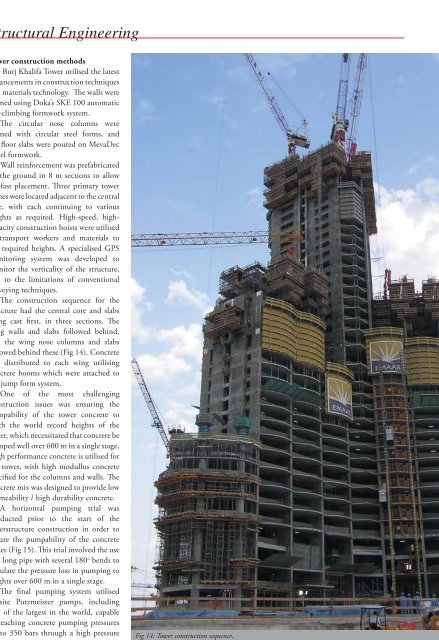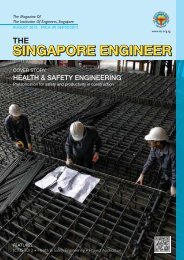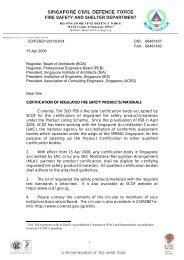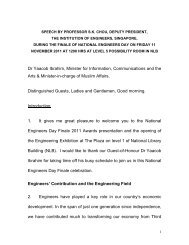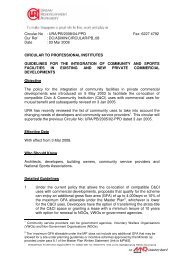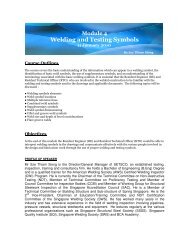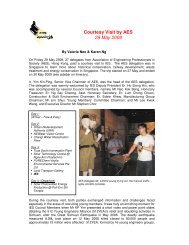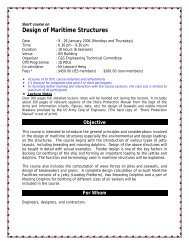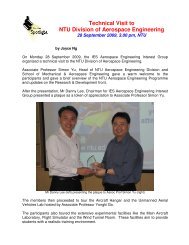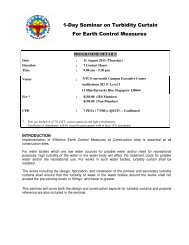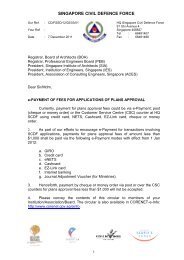News & Events - Institution of Engineers Singapore
News & Events - Institution of Engineers Singapore
News & Events - Institution of Engineers Singapore
Create successful ePaper yourself
Turn your PDF publications into a flip-book with our unique Google optimized e-Paper software.
Structural Engineering<br />
Tower construction methods<br />
The Burj Khalifa Tower utilised the latest<br />
advancements in construction techniques<br />
and materials technology. The walls were<br />
formed using Doka’s SKE 100 automatic<br />
self-climbing formwork system.<br />
The circular nose columns were<br />
formed with circular steel forms, and<br />
the floor slabs were poured on MevaDec<br />
panel formwork.<br />
Wall reinforcement was prefabricated<br />
on the ground in 8 m sections to allow<br />
for fast placement. Three primary tower<br />
cranes were located adjacent to the central<br />
core, with each continuing to various<br />
heights as required. High-speed, highcapacity<br />
construction hoists were utilised<br />
to transport workers and materials to<br />
the required heights. A specialised GPS<br />
monitoring system was developed to<br />
monitor the verticality <strong>of</strong> the structure,<br />
due to the limitations <strong>of</strong> conventional<br />
surveying techniques.<br />
The construction sequence for the<br />
structure had the central core and slabs<br />
being cast first, in three sections. The<br />
wing walls and slabs followed behind,<br />
and the wing nose columns and slabs<br />
followed behind these (Fig 14). Concrete<br />
was distributed to each wing utilising<br />
concrete booms which were attached to<br />
the jump form system.<br />
One <strong>of</strong> the most challenging<br />
construction issues was ensuring the<br />
pumpability <strong>of</strong> the tower concrete to<br />
reach the world record heights <strong>of</strong> the<br />
tower, which necessitated that concrete be<br />
pumped well over 600 m in a single stage.<br />
High performance concrete is utilised for<br />
the tower, with high modullus concrete<br />
specified for the columns and walls. The<br />
concrete mix was designed to provide low<br />
permeability / high durability concrete.<br />
A horizontal pumping trial was<br />
conducted prior to the start <strong>of</strong> the<br />
superstructure construction in order to<br />
ensure the pumpability <strong>of</strong> the concrete<br />
mixes (Fig 15). This trial involved the use<br />
<strong>of</strong> a long pipe with several 180 0 bends to<br />
simulate the pressure loss in pumping to<br />
heights over 600 m in a single stage.<br />
The final pumping system utilised<br />
on-site Putzmeister pumps, including<br />
two <strong>of</strong> the largest in the world, capable<br />
<strong>of</strong> reaching concrete pumping pressures<br />
up to 350 bars through a high pressure<br />
150 mm pipeline.<br />
Fig 14: Tower construction sequence.<br />
28 · THE SINGAPORE ENGINEER Jun 2010


